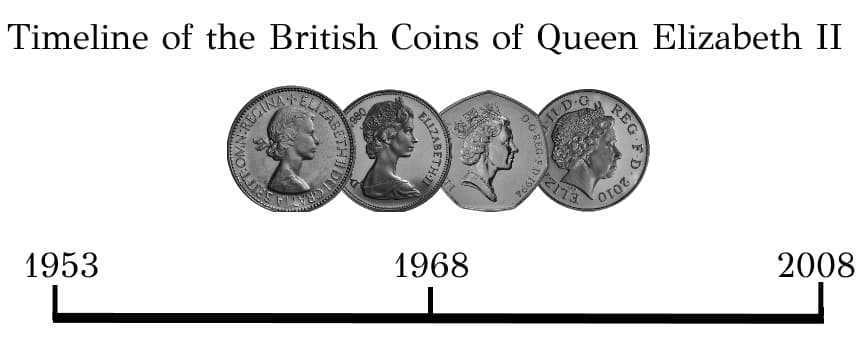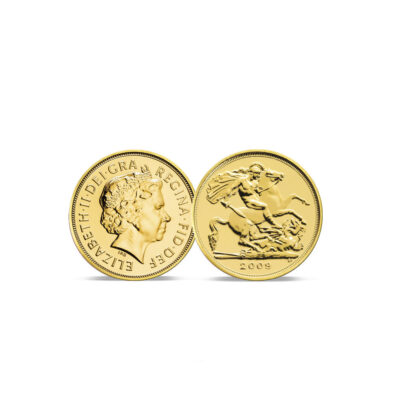
Throughout her incredible seventy-year reign, Queen Elizabeth II appeared on a multitude of different coins, from pre-decimal to now. The very first coinage portrait of Queen Elizabeth II was created by Mary Gillick in 1953, and was used on coins in the United Kingdom and other countries until 1970.
Here, we will be looking back at the British coins of Queen Elizabeth II through the years.
Pre-Decimal Coins (1953 to 1967)
The crown was worth five shillings in pre-decimal times. In Elizabeth II’s reign, crowns were issued in 1953 for the Coronation, 1960 for the New York Exposition, and 1965 for Winston Churchill’s death.
The pre-decimal coinage consisted of:
-
Halfcrown worth 2/6 (two shillings and sixpence, or 30 pence) last struck in 1967
-
Florin worth 2 shillings (24 pence) last struck 1967
-
Shilling with English lions (12 pence) last struck 1966
-
Shilling with Scottish lions (12 pence) last struck 1966
-
Sixpence last struck 1967
-
Threepence (the inspiration of the new high-tech £1 coin coming out from 2015 onwards) last struck 1967
-
Penny last struck 1967
-
Halfpenny last struck 1967
-
Farthing (quarter of a penny) last struck 1956
-
In 1970 a special collector set was struck with all the coins (halfcrown to halfpenny) but none of these coins circulated
Decimal Coins (1968 Onwards)
The second portrait of Queen Elizabeth II was created by Arnold Machin, and was used on the new decimal coinage from 1968 to 1984. In 1985, a third portrait of Her Majesty was created, this time by artist Raphael Maklout. This portrait was used until 1997.
The crown was worth twenty-five new pence in decimal times (until 1990). In Elizabeth II’s reign, crowns were issued in 1972 for the Silver Wedding anniversary of Elizabeth II and Prince Philip, 1977 for the Silver Jubilee of the reign, 1980 for the Queen Mother’s 100th birthday, and 1981 for the wedding of Charles and Diana. In 1990, the face value of the crown was changed from twenty five pence to £5 to make it more appropriate to the size of the coin. They no longer circulate and are issued as commemoratives. They have been issued in almost every year since 1990 to commemorate royal events.
To make the transition from pre-decimal to decimal smooth, the new ten pence coin was made the same size as the old florin, and the new five pence coin was made the same size as the old shilling. This meant that twelve pence in old money equalled five pence in new, and twenty-four pence in old money equalled ten pence in new. All the other coins fell into line with these ratios.
The first decimal coinage consisted of a fifty pence, ten pence, five pence, two pence, penny, and half pence. The coins all said ‘New Pence’ to differentiate them from the old (pre-decimal) pence. In 1982, the coins were renamed ‘Pence’ instead of ‘New Pence’. The first twenty pence coin was also minted in 1982, and the first £1 coin was minted in 1983. The half pence was minted in 1984, however, its purchasing power was so small that it was discontinued.
Decimal Coins ‘Shield’ Series (2008 Onwards)
The fourth coinage portrait of Queen Elizabeth II was created by Ian Rank-Broadley. This was used from 1998 to 2015, when Jody Clark won a competition to become the fifth artist to design the portrait. The original decimal designs were changed in 2008 to the modern ‘shield segments’ series.
The bi-metallic £2 coin was first minted in 1997. The fifty pence was reduced in size in 1997, with the ten pence being reduced in 1992, and the five pence in 1990. This was to make them more efficient to produce. This meant the ten pence and five pence were no longer the same size as their pre-decimal ‘partners’ from those dates onwards. In 2017, a 12-sided bi-metallic £1 coin was issued in the United Kingdom.
Looking to gold sovereigns? We have a variety of them available with the Queen Elizabeth II portraits mentioned throughout this blog. You can browse them HERE.



